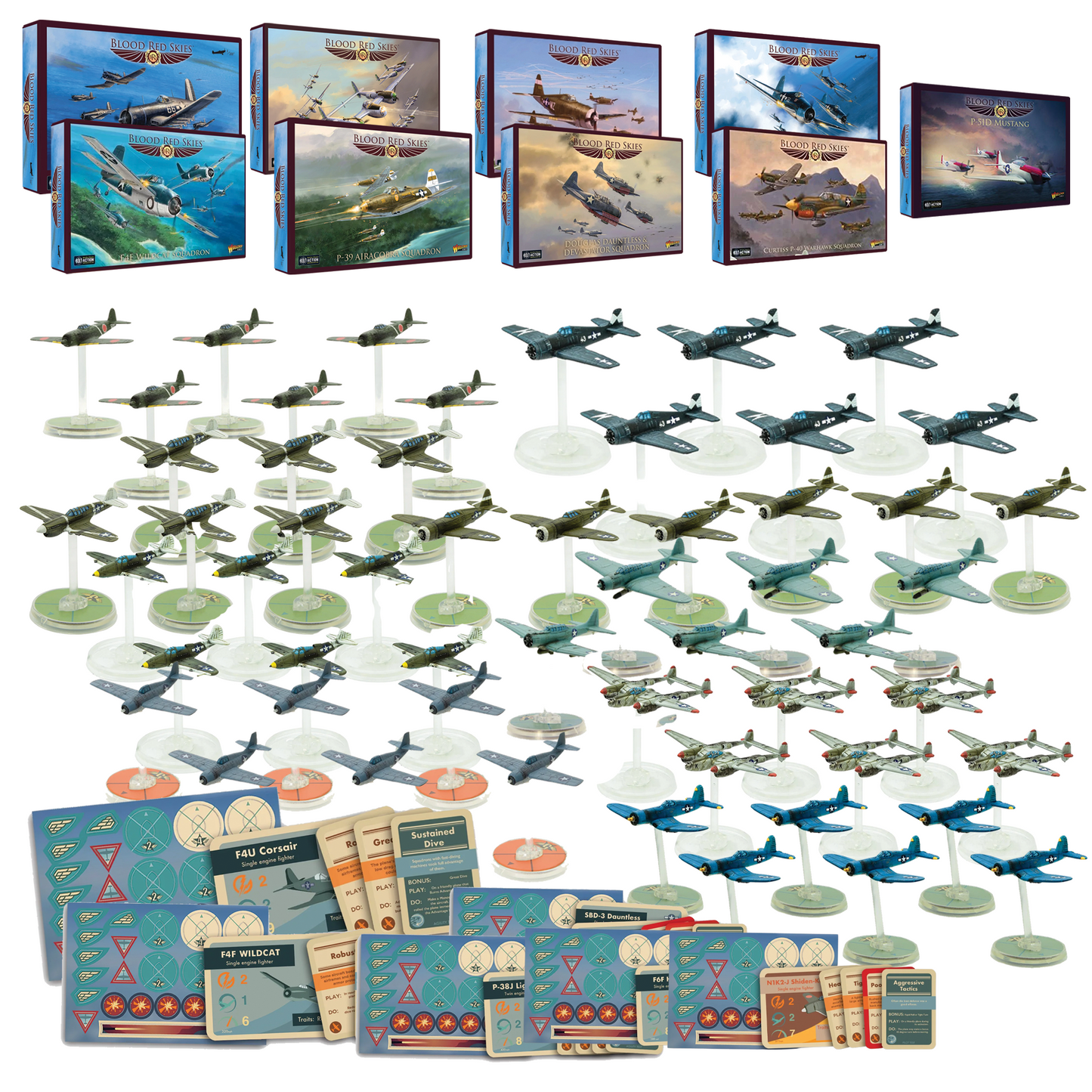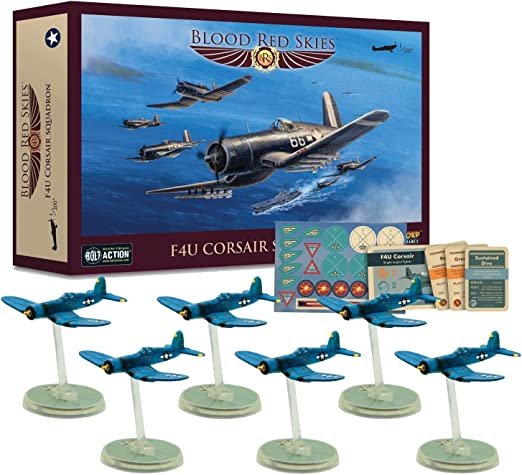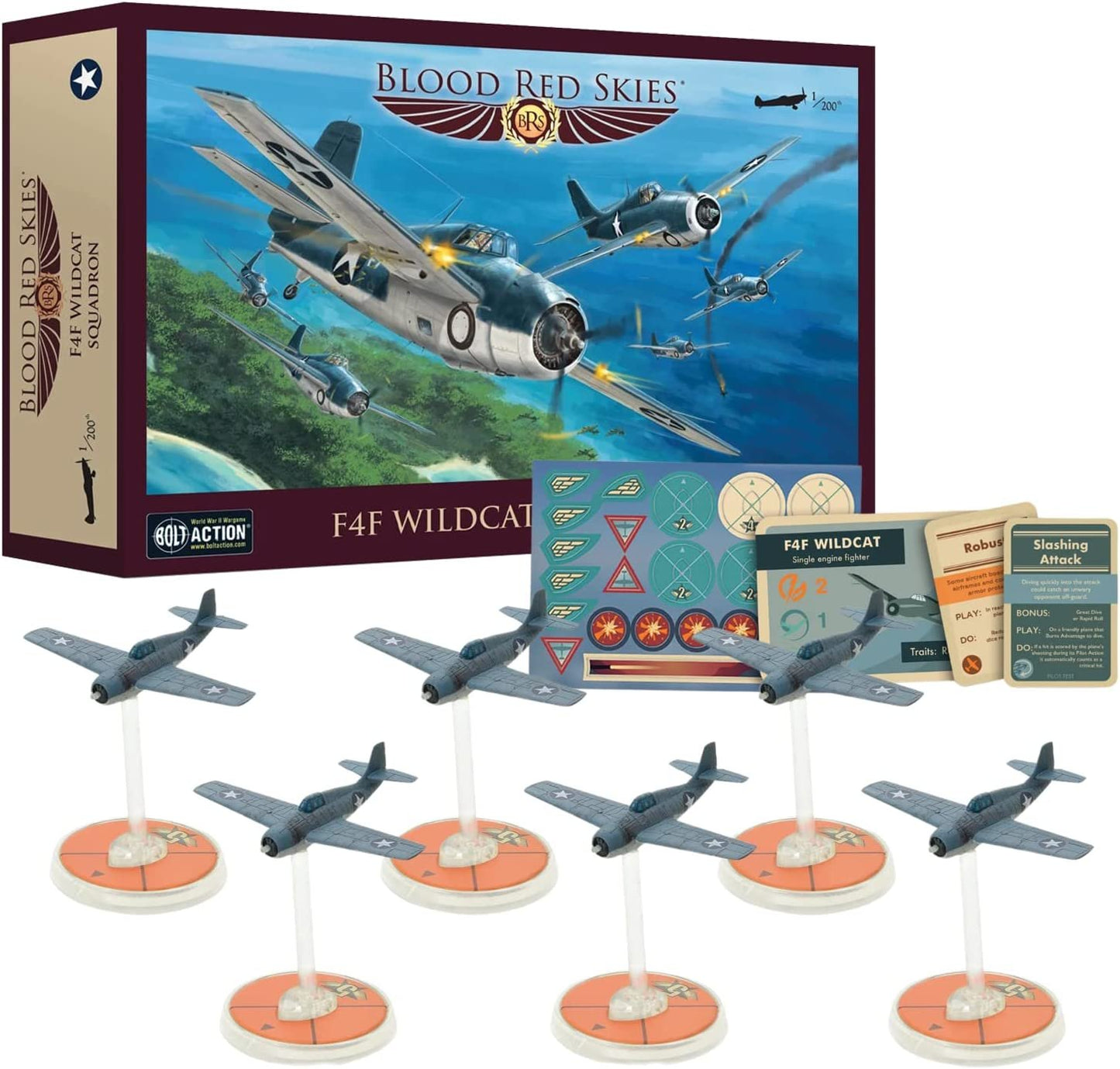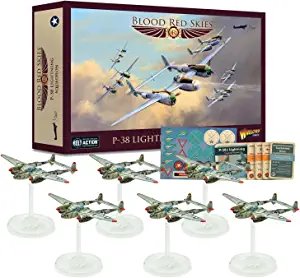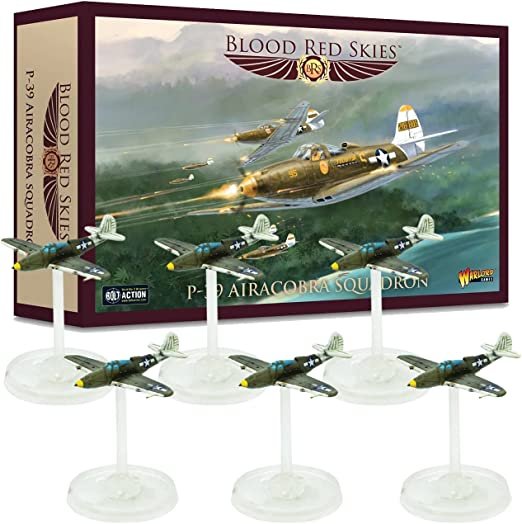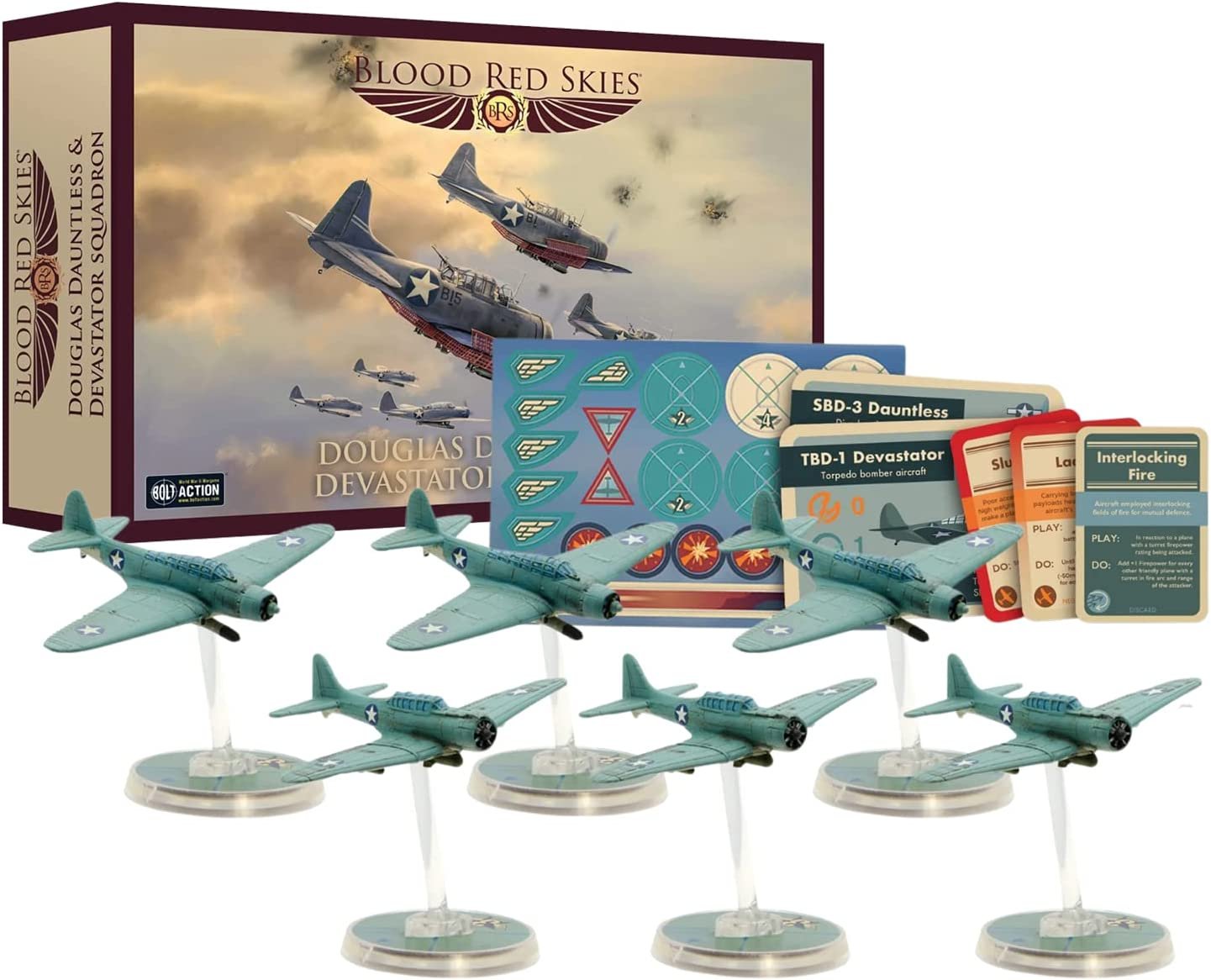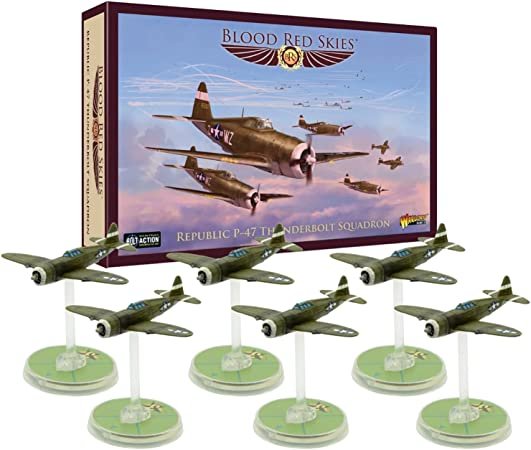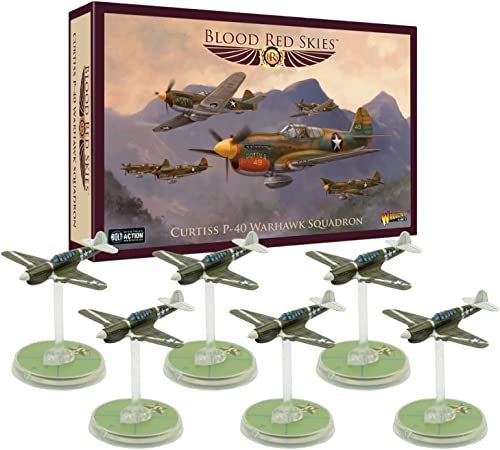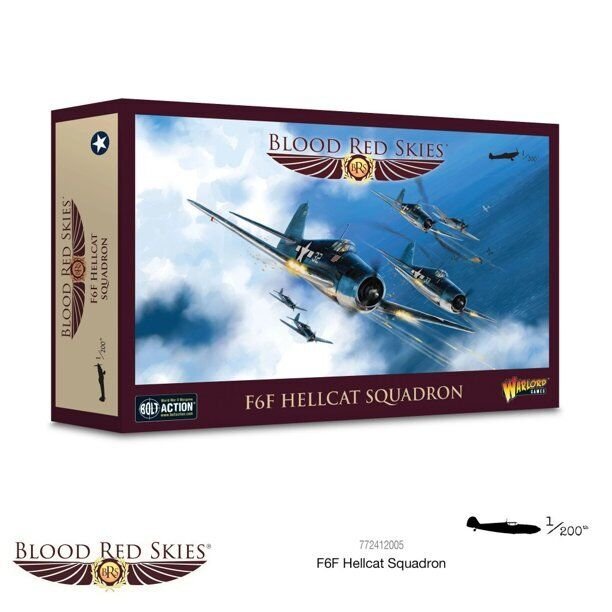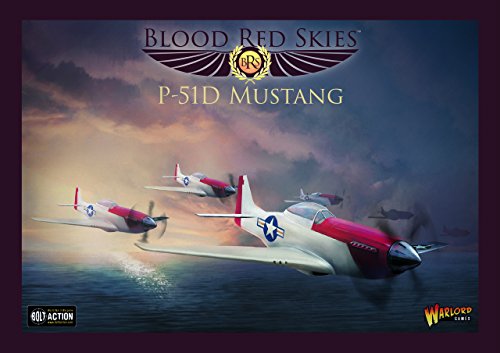Warlord Games
Blood Red Skies - US Air Force Bundle
Couldn't load pickup availability

A Wargames Delivered Exclusive Bundle containing everything you need to paint your US Air Force.
Includes:
- Blood Red Skies - US Air Force: F4U Corsair Squadron
- Blood Red Skies - US Air Force: F4F Wildcat Squadron
- Blood Red Skies - US Air Force: P-38 Lightning Squadron
- Blood Red Skies - US Air Force: P-39 Airacobra Squadron
- Blood Red Skies - US Air Forces: Douglas Dauntless & Devastator Squadron
- Blood Red Skies - US Air Force: Republic P-47 Thunderbolt Squadron
- Blood Red Skies - US Air Force: Curtiss P-40 Warhawk Squadron
- Blood Red Skies- US Air Forces: F6F Hellcat Squadron
- Blood Red Skies - US Air Forces: P-51 D Mustang Squadron
- The Vought F4U Corsair was designed to be a carrier-based fighter but flying from rough island airfields in tropical conditions was no impediment. Battles over Guadalcanal proved their superiority over their Japanese opponents.
The F4U flew over 60,000 operational sorties (only 9,000 sorties flown from carrier decks) for the U.S. Navy & Marines and U.S. Navy through the war (some 40% of total fighter sorties), with only 9,581 sorties (15%) flown from carrier decks. Corsairs claimed 2,140 air combat victories against 189 losses to enemy aircraft, for an overall kill ratio of over 11:1. It also proved its versatility, delivering over 70% of the total bombs dropped by U.S. fighters during the war.
Box Contents:
- 6 x Warlord Resin F4U Corsair aircraft
- 6 x Advantage Flying Base
- 1 x Punchboard with Game Tokens
- 1 x Aircraft Card (F4U Corsair)
- 1 x Doctrine Card (Sustained Dive)
- 6 x Aircraft Trait Cards (3 x Great Dive, 3 x Robust)
- 1 x Waterslide Aircraft Markings Sheet
- When the US Navy and Marine Corps entered the Second World War, they had only one effective fighter aircraft available to them: the F4F Wildcat. Fortunately, the Wildcat proved more than equal to the task of holding the line.
The Wildcat was outperformed by the lighter Japanese Zero in turning and climbing, but the Wildcat was much more robust and heavily armed than its opponent. Even when larger, more modern fighters took over the interception role, the useful little Wildcat remained in production until the end of the war.
Box Contents:
- 6 x Warlord Resin F4F Wildcat aircraft
- 6 x Advantage Flying Bases
- 1 x Punchboard with Game Tokens
- 1 x Aircraft Card (F4F Wildcat)
- 1 x Doctrine Card (Slashing Attack)
- 6 x Aircraft Trait Cards (Robust)
- 1 x Waterslide Aircraft Markings Sheet
- The P-38 Lightning’s comparatively long range proved invaluable in the Pacific Theatre and for escort duties in deep penetration raids over occupied Europe, enjoying considerable success as a ground attack strike fighter.
The twin-engined fighter enjoyed its most extensive deployment and successes in the Pacific theatre. Though it could not outmanoeuvre the A6M Zero at sub-200mph speeds, its speed and rate of climb lent it the capability of making several high speed passes in combat, and Japanese aircraft armour was more susceptible than German aircraft to the tight groupings of the P-38s guns.
It was P-38s that engaged in the fighter-intercept mission that claimed the life of Admiral Isoroku Yamamoto, architect of the attack on Pearl Harbor. In this engagement, 16 P-38G lightnings met two G4M “Betty” transports and six escorting Zeros. Both transports were lost as well as two Zeros, for the loss of one P-38.
Contents:
- 6 x Warlord Resin P-38 Lightning aircraft
- 6 x Advantage Flying Bases
- 1 x Punchboard with Game Tokens
- 1 x Aircraft Card (P-38J Lightning)
- 1 x Doctrine Card (Sustained Dive)
- 7 x Aircraft Trait Cards (3 x Heavy Hitter, 3 x Great Dive, 1 x Agile)
- 1 x Waterslide Aircraft Markings Sheet
- The Bell P-39 Airacobra was one of the principal fighters in service with US Army Air Forces upon the nation's entry into World War Two. It was also used throughout the war by (most prominently) the Soviet Air Force, the Free French, the RAF and the Italian Co-Belligerent Air Force, and thus service in most theaters, but particularly in the Southwest Pacific, Mediterranean and USSR.
Rejected for use in Western Europe by the RAF due to its relative inefficacy at high-altitude, the Soviets made good use of it on the Eastern front where the majority of air combats took place at lower altitudes. Under Soviet pilots, the P-39 collected the highest number of kills attributed to any US fighter type by any air force in any conflict.
Contents:
- 6 x Warlord Resin P-39 aircraft
- 6 x Advantage Flying Bases
- 1 x Punchboard with Game Tokens
- Aircraft & Trait Game Aid Cards
- 1 x Waterslide Aircraft Markings Sheet
- At the Battle of Midway the US Navy relied on two aircraft: the SBD-3 Dauntless dive bomber and TBD-1 Devastator torpedo bomber. At Midway, Dauntless aircraft crippled all four of the Japanese carriers.
The importance of the Douglas SBD Dauntless’ performance over the course of the war cannot be overstated. Despite relatively poor manoeuvrability and only adequate performance, it was this aircraft that crippled all four of the Japanese carriers in the theatre-defining Battle of Midway. Despite this performance, the type was phased out before war’s end, though it had only entered service in 1940.
6 Aircraft
Warlord Resin
Contents:
- 3 x Warlord Resin Dauntless aircraft
- 3 x Warlord Resin Devastator aircraft
- 6 x Advantage Flying Bases
- 1 x Punchboard with Game Tokens
- 2 x Aircraft Cards (Dauntless, Devastator)
- 1 x Doctrine Card (Interlocking Fire)
- 2 x Aircraft Trait Cards (1 x Sluggish, 1 x Laden)
- 1 x Waterslide Aircraft Markings Sheet
- The P-47 Thunderbolt was a versatile US fighter aircraft produced between 1941 and 1945 operating in both the Mediterranean and Pacific theatres. In addition to eight wing-mounted .50-caliber machine guns, it was capable of carrying five-inch rockets or a bomb load of up to 2500 pounds. When fully-loaded up in this manner, the fighter was one of the heaviest of the entire war. However, this meant it could fulfil a number of roles - performing well as a short to medium range escort fighter as well as in a ground attack role.
The P-47 earned praise form its pilots for its roll-rate and dive speed, and its general performance at high altitude. This performance would suffer at lower altitudes, however, as the climbing and turning rate would become far from optimal. The P-47 was viewed as a very large lumbering aircraft, and German pilots soon learned to climb, rather than dive, when the silhouette of a Thunderbolt loomed from behind. The P-47 was also fairly rugged, capable of sustaining a fair amount of damage, and its cockpit was roomy and offered decent visibility - this was further improved with the introduction of bubble canopies on some variants of the P47-D.
Vital Statistics
- Crew: 1
- Length: 11m
- Wingspan: 12.42m
- Max Speed: 697kph
- Combat Range: 1290km
- Armament: 8 × .50 in (12.7 mm) M2 Browning machine guns (3400 rounds); Up to 2,500 lb (1,134 kg) of bombs; 10 × 5 in (127 mm) unguided rockets
Contains 6 Warlord Resin aircraft with advantage bases & cards.
- The Curtiss P-40 Warhawk is an American single-engined, single-seat, all-metal fighter and ground-attack aircraft that first flew in 1938. Used by most Allied powers during World War II, it would see service throughout the war. It was the third most-produced of US aircraft of WW2, behind the P-51 and P-47 - with 13,738 examples produced.
Its first combat was with the British Commonwealth of the Desert Air Force over North Africa and the Middle East. Whilst Warhawk was the name utilised by all USAAF and USAAC units that employed the aircraft, other Allies used the name Tomahawk or Kittyhawk to refer to specific variants. It was thus a Commonwealth Tomahawk of No. 112 Squadron of the RAF that first adopted the iconic "shark mouth" design on an Allied aircraft.
Vital Statistics
- Crew: 1
- Length: 9.665m
- Wingspan: 11.367m
- Max Speed: 538kph
- Combat Range: 1152km
- Armament: 6 × 0.50 in (12.70 mm) M2 Browning machine guns with 235 rounds per gun in the wings; 250 to 1,000 lb (110 to 450 kg) bombs to a total of 2,000 lb (910 kg) on three hardpoints (one under the fuselage and two underwing)
Contains 6 Warlord Resin aircraft with advantage bases & cards.
- The Grumman F6F Hellcat was a rugged US Navy fighter. It performed extremely well in combat and accounted for 75% of the US Navy’s recorded aerial victories in the Pacific theatre. This astounding figure totals Japanese 5156 aircraft destroyed for the loss of only 270 F6Fs in air-to-air combat.
The initial production model entered service in August 1943, and its balance of high performance, firepower and fair agility put it in great favour with pilots. Of 4402 aircraft produced, 252 were transferred under Lend-Lease for service with the Fleet Air Arm in the UK (known as Hellcat Mk1s).
Contents:
- 6 x Warlord Resin F6F Hellcat aircraft
- 6 x Advantage Flying Bases
- 1 x Punchboard with Game Tokens
- 1 x Aircraft Card (F6F Hellcat)
- 1 x Doctrine Card (Top Cover)
- 6 x Aircraft Trait Cards (3 x Rapid Roll, 3 x Robust)
- 1 x Waterslide Aircraft Markings Sheet
- The introduction of the Merlin engine transformed the initially mediocre P-51 Mustang into a world-class fighting machine with the iconic P-51D, all but supplanting other types of fighters used by the United States Eighth Air Force in Britain. By May 1945, Mustangs had flown 213,873 stories and claimed 4,950 enemy aircraft destroyed.
The US P-51 Mustang Squadron set contains:
- 6 P-51D Mustang Fighters
- 6 Advantage flying bases
- 1 Aircraft card
- 6 Aircraft Trait Cards
- 6 Double-sided Pilot Skill Discs
- 1 Aircraft Markings Sticker Sheet
- 3 Action cards
Share
